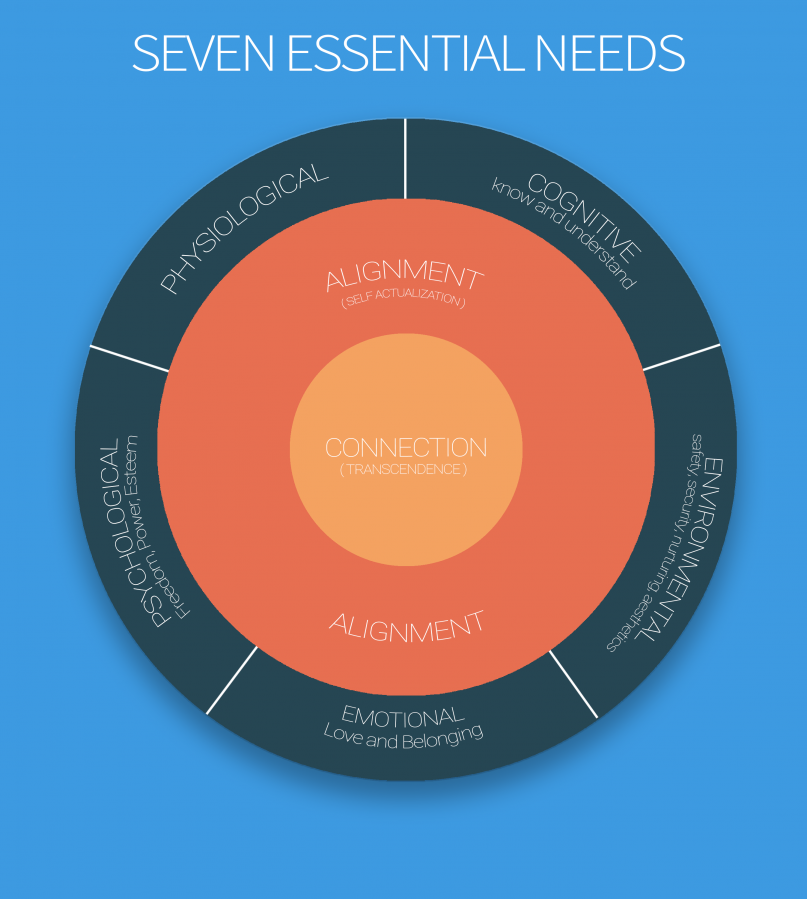
The Seven Essential Needs are the seven needs that all human beings must meet if they are to grow up healthy, happy, whole, and connected.1 Because our modern society and social fabric has been so thoroughly destroyed by Capitalism, most of us exit adolescence and live our adult lives as bundles of unmet needs. As an LP therapist or coach, or even as an LP practitioner, it is your job to scan your client’s life space to see if their essential needs are being met. If they are not, you need to help them figure out ways to meet these needs.
Note that the Seven Essential Needs are organized into a circle with three layers. Essential needs include the Basic Needs (outer circle) and also the core inner circle needs for alignment and connection.
The circular arrangement reflects a basic premise of LP Theory that in order for humans to be healthy, happy, and fully developed, all their basic needs must be sufficiently met and all “deficits...must ordinarily be fairly well satisfied” (A. H. Maslow, 1968, p. 33) before the needs for alignment and connection can be meaningfully and successful pursued. If hungry, that need must be satiated. If you need a hug, that need needs to be satisfied, sometimes even before you eat. If you need support to develop self-esteem, that need needs to be satisfied. If you need help with a sense of power, that need needs to be satisfied.
Basic Needs
There are five categories of basic needs.
Physiological Needs – Physiological needs include the need for substances (like healthy food, water, vitamins, air), the need for physical activity (exercise), the biological drives for sex, and so on. Meeting physiological needs keeps the body healthy and growing. Physiological needs also include the absence of physical pain.
Environmental Needs – Environmental needs include the need for a safe and secure environment but go further and include the need for protective, nurturing, and aesthetically pleasing environments at home, work, and everywhere. Note that safety includes the absence of assault of any kind, including physical assault (e.g., spanking, pushing, slamming objects, shaking etc.), emotional and psychological assault (screaming, name-calling, racism, sexism, shaming, passive aggressive assaults). Stability includes financial stability, which removes anxiety about work and survival, but also the emotional and psychological consistency of emotionally and psychologically stable parents and stable familial relationships. Sufficient environments are environments free of chaos and uncertainty, where all essential needs are met. There is sufficient evidence to assert that safe, calm, stable, and nurturing environments are a prerequisite to psychological health, well-being, and growth, and that lack said environments leads to various forms of distress and disease (Sosteric & Ratkovic, 2016). Ultimately, we need an environment that is safe, nurturing, secure, calm, aesthetic and that encourages “free, uninhibited, uncontrolled, trusting, unpremeditated expression of the self ” (A. H. Maslow, 1967, p. 197)and the expression of “pure spontaneity.”
Cognitive Needs – Cognitive needs include our need to know and understand ourselves and the world. Our human needs to know and understand are self-evident. We see these expressed in children as soon as they begin to talk and ask questions. In healthy individuals, these needs are impossible to satiate. Healthy growth requires continuous learning. Cognitive needs are thwarted in environments where lying and neglect are common, or in environments soaked with propaganda and ideology. Parents can often interfere with the satisfaction of cognitive needs by failing to attend to their children’s questions. Schools can thwart satisfaction of cognitive needs when they do not allow space for free inquiry and exploration, or when teachers are driven by ideology, racism, or other forms of blindness. The mass media often lies by omission, failing to report certain stories while focusing attention on others. Forms of toxicity like gas lightning also figure in here. Gaslighters divert your attention from the truth of their own behaviour by focusing your attention back on you. There are a lot of different ways to avoid truth and understanding. As an LP practitioner, it is your job to help the client sort this out.
Emotional Needs – Emotional needs include our “love and belonging needs.” This includes our need for love, support, acceptance, and inclusion in family, friend groups, and in society.
Emotional needs almost always go unmet in our modern society because most people have only ever experienced, conditional forms of love and acceptance, even from their parents. Add to that the fact that many of our basic and essential needs go unmet and we find that interactions with others, even parents and intimate partners, become transactional, meaning you only get love when you do something for them, or they only get love when they do something for you. This is the same for peer groups and others who are often so deprived of needs satisfaction that they become needy little narcissistic vampires whose only conscious and unconscious goal is to find and use others to meet their own unmet needs.
As an LP Practitioner, it is your job to help an individual learn to identify those situations and people where interactions are primarily transactional and where, as a consequence, emotional needs stand little chance of being satisfied. This can be difficult since clients can often be so desperate to find authentic human connection and healthy human relationships that they will sacrifice their own emotional and mental well-being and even the well-being of their partners and children. It is important to raise the client’s awareness of the simple fact that participating in transactional relationships will never lead to authentic satisfaction of basic needs and in fact will only deplete their energy and life force.
Psychological Needs – Psychological needs include our self-esteem needs, our need for freedom, and our need for power.
Esteem needs - according to Maslow, esteem needs contain two subsidiary sets of needs, “these are, first, the desire for strength, for achievement, for adequacy, for confidence in the face of the world, and for independence and freedom. Secondly, we have what we may call the desire for reputation or prestige (defining it as respect or esteem from other people), recognition, attention, importance or appreciation” (A. H. Maslow, 1943, pp. 381–382).
Power needs – Power is the phenomenological sense that one can change the world in accord with one’s desires. Power is “the feeling of having some control over fate, of not being a helpless tool, a passive object, a cork on the wave which is tossed here and there by forces out of control” (A. Maslow, 1961, p. 2). Power is the sense that one has control over one’s environment and can modify it to suit predilections.
Freedom needs – Freedom includes “Such conditions as freedom to speak, freedom to do what one wishes so long as no harm is done to others, freedom to express oneself, freedom to investigate and seek for information, freedom to defend oneself, justice, fairness, honesty, orderliness in the group are examples of such preconditions for basic need satisfactions” (A. H. Maslow, 1970, p. 47); Freedom is the need to explore, grow, and develop in line with one’s preferences and predilections. As Maslow says, we need to be free in environments where permission is granted “to gratify and to express” (A. H. Maslow, 1970, p. 276). In order to be in a healthy psychological space, we need to feel confident in our abilities and have the power and freedom to grow and learn in line with our own needs and any community predilections.
Note that developing a sense of power in children involves action on the part of parents, teachers, and others who are more powerful. Protective parents who monitor the environment for threats provide children with the freedom they need to explore, that they would not otherwise have. Overly controlling parents thwart a child’s abilities to express and experience freedom.
Need for Alignment
Within the outer circle of basic needs are two inner circles. The first inner circle is the need for alignment. By alignment, we mean alignment with the inner self (actualization of one’s inner self, as per Maslow) but also alignment with what is right and proper in all areas of life. One aligns with one’s community, one’s ancestors, with ethical and moral systems of right thought, right action, and so on.Note that alignment, like connection, requires a healthy Physical Unit with strong and healthy Bodily Ego, strong self-esteem and a strong sense of power and autonomy, since staying aligned often involves the ability to stay centered and aligned in various settings, like marketing firms, the military, exploitative workplaces, etc., which may not be supportive of alignment.
Need for Connection
Finally, we have the inner circle or core of the human being which is the need for connection. Connection here involves the weakening/dissolution of the Atomized Individual Self and the development of greater connection to the world, to our children and friends, and to other human beings. As Maslow says, when “the distinction between self and not-self has broken down (or has been transcended) [there is now] less differentiation between the world and the person because he has incorporated into himself part of the world...His self has enlarged enough to include his child. Hurt his child and you hurt him....[he has fused] with the non-self..[which includes]...not only...the world of nature...[but] other humans beings...[to the point that]...’selves overlap” (A. H. Maslow, 1967, p. 103).
Connection also includes connection to the spiritual realms, as indicated and developed in traditional shamanic practices, Catholic mysticism, Aboriginal dream times. Connection to the spiritual realms may include connection to your own Highest Self (your soul/atman/) but also connection to nature, the cosmos, and even to divine union with “God” (Ernst, 1997; Kalisch, 2006; St. Teresa of Avila, 2007; Steeman, 1975; Underhill, 2002). Psychologist William James reflects the notions of alignment and connection perfectly when he says "Were one asked to characterize the life of religion in the broadest and most general terms possible, one might say that it consists of the belief that there is an unseen order, and that our supreme good lies in harmoniously adjusting ourselves thereto” (James, 1982, p. 53).
We realize there may be objections to including the concept of “spirit,” which we would simply conceptualize as consciousness independent of physical matter, in the discussion. If one is not prepared to take seriously what humans have known about and experienced for thousands and thousands of years, i.e., that there are realms of consciousness and aspects of reality that are non-material and beyond our day-to-day normal consciousness, and that the goal of human development is to connect with these realities, one can reduce connection to activation of brain neurology and leave it at that (Andew Newberg et al., 2001; Andrew Newberg, 2006). However, we would argue that failure to recognize this basic truth of human existence and experience necessarily hamstrings the eupsychian project by excluding the possibility of this highest attainment of human health, well-being, and development.
Footnotes
1For a discussion of the Seven Essential Needs in the context of Eupsychian Theory, and to see how the LP theory builds upon the work of psychologist Abraham Maslow, see (Sosteric & Ratkovic, 2020)
References
Ernst, C. W. (1997). The Shambhala Guide to Sufism. Shambhala Publications. https://amzn.to/2SoFmun
James, W. (1982). The Varieties of Religious Experience: A Study of Human Nature. Penguin. https://amzn.to/2l4UyR7
Kalisch, I. (2006). Sepher Yezirah: A Book on Creation. The Book Tree. https://amzn.to/2WPnklN
Maslow, A. (1961). Eupsychia—The Good Society. Journal of Humanistic Psychology, 1(2), 1.
Maslow, A. H. (1943). A Theory of Human Motivation. Psychological Review, 50(4), 370–396.
Maslow, A. H. (1967). A theory of metamotivation: The biological rooting of the value-life. Journal of Humanistic Psychology, 7, 93–127.
Maslow, A. H. (1968). Towards a Psychology of Being (2nd Edition). Van Nostrand Reinhold Company.
Maslow, A. H. (1970). Motivation and Personality (2nd ed.). Harper & Row. https://amzn.to/2OSRmlX
Newberg, Andew, d’Aquile, E., & Rause, V. (2001). Why God Won’t Go Away: Brain Science and the Biology of Belief. Ballantine Books.
Newberg, Andrew. (2006). The neurobiology of spiritual transformation. In P. Hefner & J. Koss-Chioino (Eds.), Spiritual Transformation and Healing: Anthropological, Theological, Neuroscientific, and Clinical Perspectives,. Rowman & Littlefield.
Sosteric, M., & Ratkovic, G. (2016). Toxic Socialization. https://www.academia.edu/25275338/Toxic_Socialization
Sosteric, M., & Ratkovic, G. (2020). Eupsychian Theory: Reclaiming Maslow and Rejecting The Pyramid The Seven Essential Needs. PsyArXiv Preprints. https://doi.org/10.31234/osf.io/fswk9
St. Teresa of Avila. (2007). Interior Castle (Kindle). Dover Publications. https://amzn.to/2GpC7NG
Steeman, T. M. (1975). Church, sect, mysticism, denomination: Periodological aspects of Troeltsch’s types. SA. Sociological Analysis, 36(3), 181–204. rfh.
Underhill, E. (2002). Mysticism: A Study in the Nature and Development of Spiritual Consciousness (Kindle). Dover Publications. https://amzn.to/2C91xNY
Mike Sosteric (Dr. S.) |
|
|
Just another loud mouth sociology professor, teaching sociology courses at Athabasca University. Check me out here at the Socjourn, over there at The Conversation and at academia.edu. |


Beautiful. Thank you. Your system coincides a lot with the chakra system, making everything more interesting.
Please update the broken links.
Many thanks.
I am 79 yrs old. All my life my “self identity has been that of a “little boy.” (it is my “central emotional position” which Kubie talks about) I have done psychotherapy since 1974, and I can’t seem to escape it. It is the first thing I think about when I wake up in the morning, along with all the things I have done wrong in my life. I have studied much about Maslow’s B-needs and D-needs. I have had two terrible marriages, and have never had a woman who truly loved me and visa versa. (a “deficiency need.”) I am a retired physician in 2013, but I can not mobilize any motivation. I think about suicide alot, but it would hurt too many people (I have 3 sons.) When I was in college, starting at age 17, I wrote an English paper, which started out “Maybe it would have been better if I had never been born.” And I still believe that. I work on all this stuff with my psychotherapist, but don’t seem to make much progress. Although we don’t know each other, I wish you well and ask you to keep up your work. Tom Bauer (MD)
Perhaps one of the reasons you don’t make much progress is because psychotherapy has no conception of higher, more “spiritual” needs for [wiki]Connection[/wiki]. Even if psychotherapy does admit human spirituality, its conceptions would primarily be primitive and ideological. In my view, any therapy that cannot speak to your need for connection cannot ever be anything more than a bandaid attempt to cover over the damage done by the System.
If you ever want to chat about things, let me know. Also, I recommend
https://www.lightningpath.org/
if you’re looking for a better way.